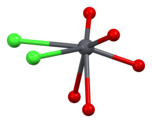Vanadinite
| Vanadinite | ||
|---|---|---|
Specific gravity 6.8–7.1 (measured) 6.95 (calculated) | | |
| Optical properties | Uniaxial (−) | |
| Refractive index | nω = 2.416, nε = 2.350 | |
| Birefringence | δ = 0.066 | |
| Ultraviolet fluorescence | Red-orange under near-UV (405nm) | |
| Melting point | 3,470 °F (1,910 °C) | |
| References | [2][3][4] | |
Vanadinite is a
Origins
Vanadinite is an uncommon mineral, only occurring as the result of chemical alterations to a pre-existing material. It is therefore known as a secondary mineral. It is found in
It was originally discovered in Mexico by the Spanish mineralogist Andrés Manuel del Río in 1801. He called the mineral "brown lead" and asserted that it contained a new element, which he first named pancromium and later, erythronium. However, he was later led to believe that this was not a new element but merely an impure form of chromium. In 1830, Nils Gabriel Sefström discovered a new element, which he named vanadium. It was later revealed that this was identical to the metal discovered earlier by Andrés Manuel del Río. Del Río's "brown lead" was also rediscovered, in 1838 in Zimapan, Hidalgo, Mexico, and was named vanadinite because of its high vanadium content. Other names that have since been given to vanadinite are johnstonite and lead vanadate.[6]
Occurrence
Vanadinite occurs as a secondary mineral in the
Deposits of vanadinite are found worldwide including Austria, Spain, Scotland, the Ural Mountains, South Africa, Namibia, Morocco, Argentina, Mexico, and four states of the United States: Arizona, Colorado, New Mexico, and South Dakota.[3][5][7]
Vanadinite deposits are found in over 400 mines across the world. Notable vanadinite mines include those at Mibladen and Touisset in Morocco; Tsumeb, Namibia; Cordoba, Argentina; and Sierra County, New Mexico, and Gila County, Arizona, in the United States.[8]
Structure
Vanadinite is a lead chlorovanadate with the chemical formula Pb5(VO4)3Cl. It is composed (by weight) of 73.15% lead, 10.79% vanadium, 13.56% oxygen, and 2.50% chlorine. Each structural unit of vanadinite contains a chlorine ion surrounded by six
Crystals of vanadinite conform to a
Characteristics
Vanadinite is in the
Vanadinite is usually bright-red or orange-red in colour, although sometimes brown, red-brown, grey, yellow, or colourless. Its distinctive colour makes it popular among mineral collectors. Its
Vanadinite is very brittle, producing small,
Uses
Along with
Image gallery
-
Vanadinite inhexagonalshaped crystals
-
Vanadinite that does not show the characteristic red colour
-
A cluster of vanadenite crystals, showing their hexagonal shape
-
Vanadinite on barite, from Mibladene, Upper Moulouya lead district, Midelt, Drâa-Tafilalet Region, Morocco
-
Crystals of vanadinite (var. endlichite), from Touissit, Touissit District, Oujda-Angad Province, Oriental Region, Morocco
-
Crystals of vanadinite and siderite, from Taouz Er Rachidia Province, Drâa-Tafilalet Region, Morocco
See also
References
- S2CID 235729616.
- ^ a b c d "Vanadinite Mineral Data". WebMineral.com. Retrieved 9 June 2007.
- ^ a b c d e f "Vanadinite". MinDat.org. Retrieved 9 June 2007.
- ^ ISBN 0962209732.
- ^ a b c d e f Treasures of the Earth: The Minerals and Gemstone Collection – Vanadinite factsheet. Orbis Publishing Ltd. 1995.
- S2CID 197594307.
- ^ a b Spencer, Leonard James (1911). . In Chisholm, Hugh (ed.). Encyclopædia Britannica. Vol. 27 (11th ed.). Cambridge University Press.
- ^ "Vanadinite". Minerals.net. Retrieved 26 June 2007.
- ^ J. Trotter & W. H. Barnes (1958). "The Structure of Vanadinite" (PDF). The Canadian Mineralogist. Retrieved 26 June 2007.
- ^ Dai, Yongshan; Hughes, John M. (1989). "Crystal structure refinements of vanadinite and pyromorphite" (PDF). Can. Mineral. 27 (2): 189–192.
- ^ Donal O'Leary (2000). "Vanadium". University College Cork. Archived from the original on 5 February 2017. Retrieved 26 June 2007.
External links
 Media related to Vanadinite at Wikimedia Commons
Media related to Vanadinite at Wikimedia Commons











